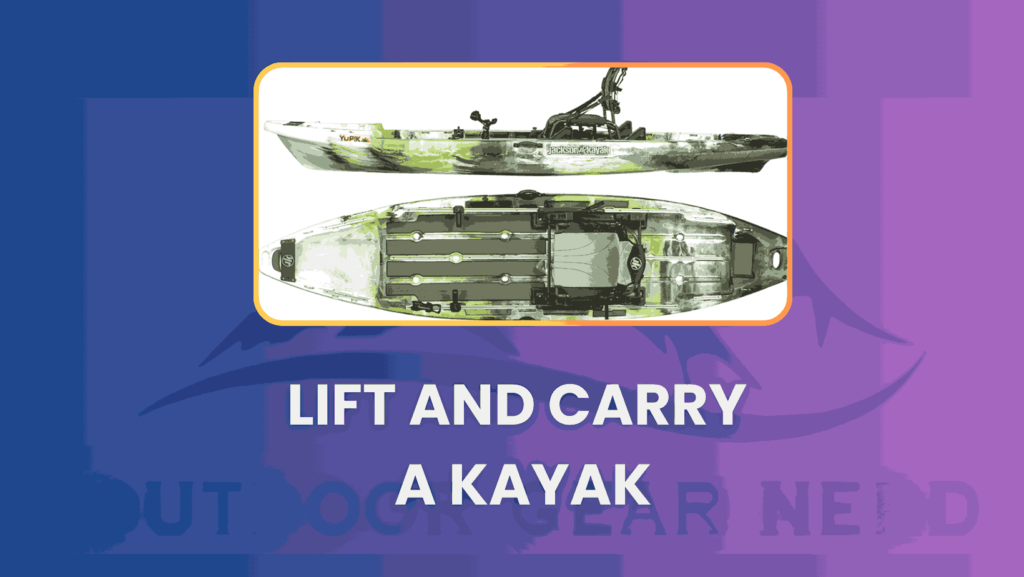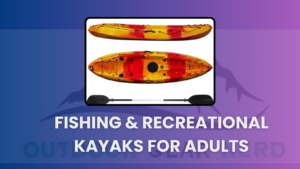Is It Safe to Drag Your Kayak?
Dragging a kayak can be tempting, but it’s not always advisable. Rough terrains can cause significant damage to your kayak’s hull. If you must drag it, lead from the bow and avoid abrasive surfaces.
On softer grounds like sand or grass, short-distance dragging is generally fine. However, if you frequently drag your kayak, investing in a protective skid plate can help prevent excessive wear.
Important: Never drag composite or fiberglass kayaks, as their delicate hulls are prone to damage.
Best Way to Carry a Kayak (or Two) With a Partner
Carrying a kayak is straightforward with a partner, and managing two kayaks can be just as smooth.
Positioning: Stand at opposite ends of the kayak, ensuring you both face forward to avoid awkward backward movements.
Identify Grip Points: Locate handles or toggles at the bow and stern. If these aren’t available, grasp the kayak under the bow or stern for a secure hold.
Lift in Unison: Squat down with your back straight, grip the identified points, and use a countdown — “Ready? One, two, three!” — to lift together, ensuring even weight distribution.
Walk in Tandem: Move forward at a synchronized pace, with the person at the bow leading and alerting the stern person to obstacles. Communicate regularly to adjust grips, change direction, or take breaks.
Handling Two Kayaks: Place the kayaks side by side. Each person should grasp a handle from both kayaks to keep them parallel. Lift together and proceed smoothly.
Tools and Accessories to Assist in Carrying a Kayak
Whether you’re navigating solo or with a partner, the right accessories can make transporting your kayak much easier. Here are two standout options to consider:
Kayak Carts
Suspenz DLX Kayak Cart: When transporting a kayak between your vehicle and the water’s edge, a kayak cart can be a game-changer. Also known as kayak trolleys or dollies, these carts support your kayak and let you roll it with ease. Ideal for use on even terrains like boat ramps and grassy banks, many models can handle various surfaces, from sandy shores to pebbled paths.
Secured either at the kayak’s end or its center, the cart elevates the kayak, protecting it from damage and wear. Designed with portability in mind, many carts fold or assemble quickly, making them easy to store in your vehicle or kayak hatch.
Kayak carts typically range from $40 to $250, catering to different budgets. For more detailed options and reviews, check out our guide on the best kayak carts. Alternatively, if you’re inclined toward DIY projects, numerous online resources provide plans for homemade carts, allowing you to customize your gear to fit your specific needs.
Additional Accessories
Investing in a kayak cart can greatly enhance your ease of transport, but don’t overlook other helpful tools and accessories that can make carrying your kayak a breeze. Explore various options to find the best fit for your paddling adventures.
Kayak Carry Straps
SUP Sling Kayak, Canoe, and SUP Big Board Schlepper Strap Carrier
Kayak carry straps, also known as shoulder straps or sling systems, offer a straightforward and efficient way to transport your kayak. These straps wrap around the kayak’s body, creating a makeshift harness. The central section is typically padded for added comfort, allowing the weight of the kayak to be distributed evenly across your shoulder and back.
While kayak carry straps are lightweight and convenient for short distances, they may not be ideal for longer hauls or heavier kayaks. Before using this method, consider the length of your journey and the weight of your kayak to ensure it meets your needs effectively.
Kayak Carrying Tips and Precautions
Whether you’re an experienced paddler or new to kayaking, carrying your kayak safely and efficiently is essential. Here are key tips and precautions to ensure a smooth and damage-free transport:
- Warm Up First
Just as you wouldn’t start an intense workout without warming up, prepare your muscles before lifting a kayak. Engage in dynamic stretches focusing on your legs, back, and shoulders to reduce the risk of strain and prepare your body for the task.
- Choose Proper Footwear
Walking on slippery surfaces with inadequate footwear can be dangerous. Opt for sturdy water shoes or sandals with good traction to enhance stability and prevent slips. For more detailed advice on appropriate gear, check our guide on what to wear kayaking.
- Lift With Your Legs
Always lift with your legs, not your back. Your leg muscles are stronger and more capable of handling the load, which reduces the risk of back injuries. Bend your knees, keep your back straight, and use your legs to lift the kayak.
- Wear a Personal Flotation Device (PFD)
Even when not on the water, wearing a PFD can be beneficial. It not only provides an extra layer of safety but also acts as a cushion when carrying the kayak on your shoulder. It’s better to be prepared for unexpected incidents.
- Be Mindful of Your Surroundings
Stay aware of your environment while carrying the kayak. Look out for obstacles such as rocks or low-hanging branches, and navigate carefully to avoid collisions. Additionally, be considerate of others around you, especially in crowded areas.
- Check Weather Conditions
Before setting out, review the weather forecast. Strong winds can make carrying a kayak challenging, particularly if you’re alone. If adverse conditions are predicted, consider postponing your trip or seeking help to transport your kayak.
By following these tips, you’ll ensure a safer and more efficient kayak transport, minimizing the risk of damage and enhancing your overall kayaking experience.
In Conclusion
Carrying a kayak, whether solo or with a partner, requires both technique and mindfulness. The journey from your vehicle to the water’s edge presents various challenges, but with the right methods, tools, and precautions, you can make it a smooth process.
Remember, mastering this skill takes practice. If you’re new to kayaking or have a new kayak, spend some time getting to know its weight and balance. Don’t hesitate to seek help when needed, and tap into the supportive kayaking community—there’s always someone ready to offer assistance.
Once you’re comfortable with carrying your kayak, your next step is to ensure it’s securely tied down for transport. For detailed guidance on this crucial task, explore our comprehensive article on how to load and tie down a kayak.





